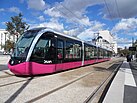
Back Dijon Afrikaans Dijon AN ديجون Arabic ديجون ARZ Dijon AST Dijon Aymara Dijon Azerbaijani دیژون AZB Дижон Bashkir Dijon BAN
Dijon | |
|---|---|
Prefecture and commune | |
Tramway de Dijon | |
| Coordinates: 47°19′00″N 5°01′00″E / 47.316667°N 5.016667°E | |
| Country | France |
| Region | Bourgogne-Franche-Comté |
| Department | Côte-d'Or |
| Arrondissement | Dijon |
| Canton | Dijon-1, 2, 3, 4, 5 and 6 |
| Intercommunality | Dijon Métropole |
| Government | |
| • Mayor (2020–2026) | François Rebsamen[1] (PS) |
Area 1 | 40.41 km2 (15.60 sq mi) |
| Population (2021)[2] | 159,346 |
| • Density | 3,900/km2 (10,000/sq mi) |
| Demonym(s) | Dijonnais (masculine) Dijonnaise (feminine) |
| Time zone | UTC+01:00 (CET) |
| • Summer (DST) | UTC+02:00 (CEST) |
| INSEE/Postal code | 21231 /21000 |
| Elevation | 220–410 m (720–1,350 ft) (avg. 245 m or 804 ft) |
| Website | www |
| 1 French Land Register data, which excludes lakes, ponds, glaciers > 1 km2 (0.386 sq mi or 247 acres) and river estuaries. | |
Dijon (UK: /ˈdiːʒɒ̃/, US: /diːˈʒoʊn/;[3][4] French: [diʒɔ̃] )[a] is a city that serves as the prefecture of the Côte-d'Or department and of the Bourgogne-Franche-Comté region in eastern France.[5] As of 2017[update] the commune had a population of 156,920.
The earliest archaeological finds within the city limits of Dijon date to the Neolithic period. Dijon later became a Roman settlement named Divio, located on the road between Lyon and Paris. The province was home to the Dukes of Burgundy from the early 11th until the late 15th centuries, and Dijon became a place of tremendous wealth and power, one of the great European centres of art, learning, and science.[6]
The city has retained varied architectural styles from many of the main periods of the past millennium, including Capetian, Gothic, and Renaissance. Many still-inhabited townhouses in the city's central district date from the 18th century and earlier. Dijon's architecture is distinguished by, among other things, toits bourguignons (Burgundian polychrome roofs) made of glazed terracotta tiles of various colours arranged in geometric patterns.
Dijon holds an International and Gastronomic Fair every year in the northern-hemisphere autumn. Dijon also hosts every three years the international flower show Florissimo. Dijon has become famous for Dijon mustard, which originated in 1856, when Jean Naigeon of Dijon substituted verjuice, the acidic "green" juice of not-quite-ripe grapes, for vinegar in the traditional mustard recipe. Dijon is a green city with an important tertiary sector, as well as a regional economic centre with a diversified fabric, a traditional food-processing center (Dijon crême de cassis and kir, gingerbread, Lanvin chocolate...) and a renowned pharmaceutical sector.
On 4 July 2015, UNESCO registered the historical centre of the city as a World Heritage site, as one of the components of the "Climats, terroirs of Burgundy" site, because of its historical importance in regulating the system of wine production in Burgundy.[7]
- ^ "Répertoire national des élus: les maires" (in French). data.gouv.fr, Plateforme ouverte des données publiques françaises. 13 September 2022. Archived from the original on 28 June 2020. Retrieved 24 November 2022.
- ^ "Populations légales 2021" (in French). The National Institute of Statistics and Economic Studies. 28 December 2023.
- ^ Wells, John C. (2008). Longman Pronunciation Dictionary (3rd ed.). Longman. ISBN 978-1-4058-8118-0.
- ^ Jones, Daniel (2011). Roach, Peter; Setter, Jane; Esling, John (eds.). Cambridge English Pronouncing Dictionary (18th ed.). Cambridge University Press. ISBN 978-0-521-15255-6.
- ^ "Destination Dijon and Burgundy - Palais des Congrès". www.dijon-congrexpo.com. Archived from the original on 28 December 2017. Retrieved 19 June 2017.
- ^ "Dukes of Burgundy, the History of Burgundy, France - burgundytoday". www.burgundytoday.com. Archived from the original on 30 April 2012. Retrieved 19 June 2017.
- ^ mondial, UNESCO Centre du patrimoine. "Les Climats du vignoble de Bourgogne". UNESCO Centre du patrimoine mondial (in French). Archived from the original on 26 April 2020. Retrieved 13 April 2023.
Cite error: There are <ref group=lower-alpha> tags or {{efn}} templates on this page, but the references will not show without a {{reflist|group=lower-alpha}} template or {{notelist}} template (see the help page).










